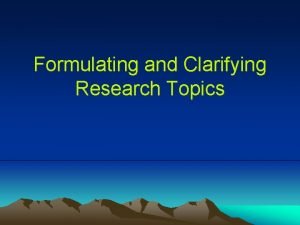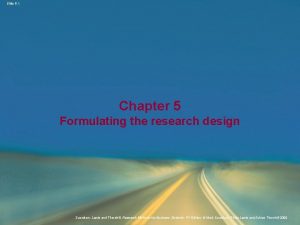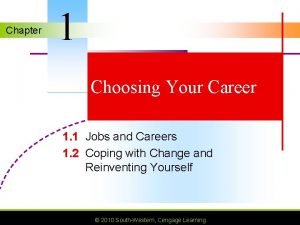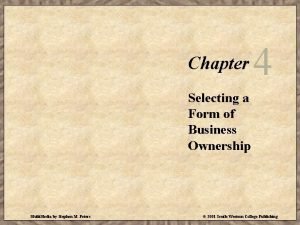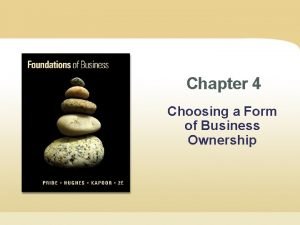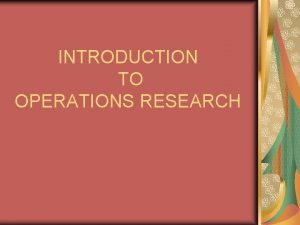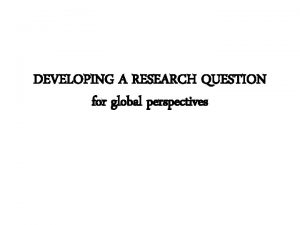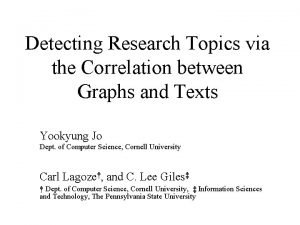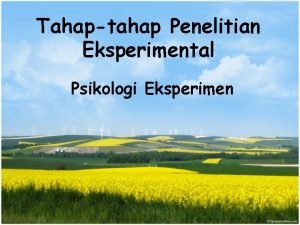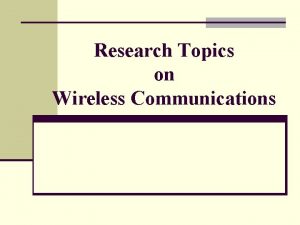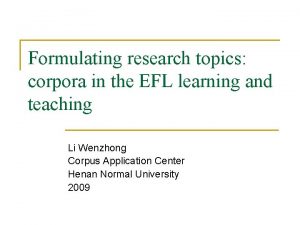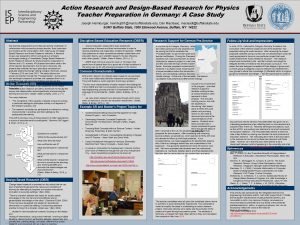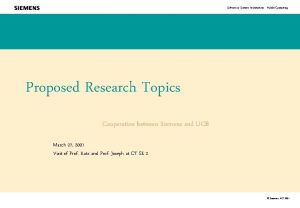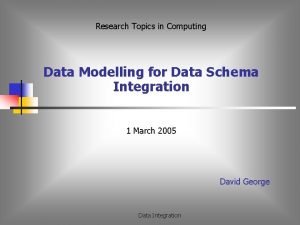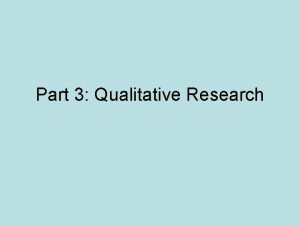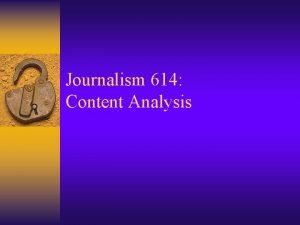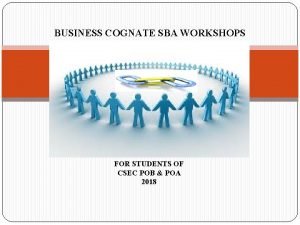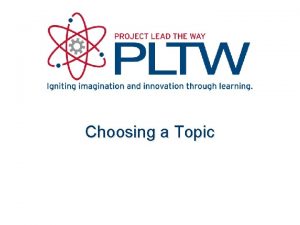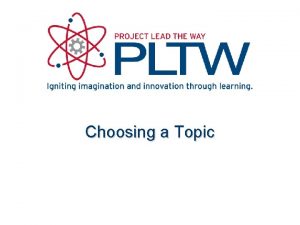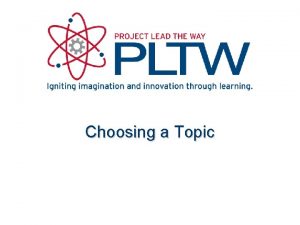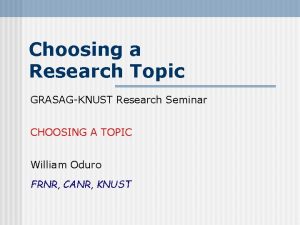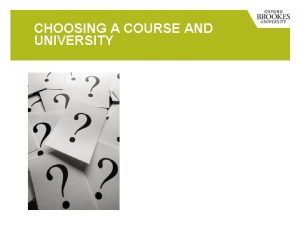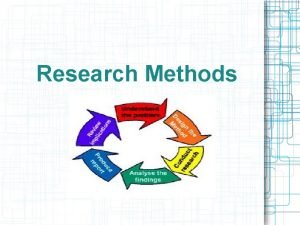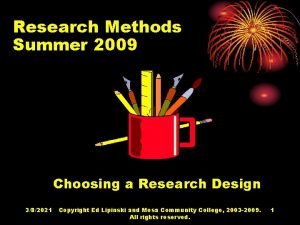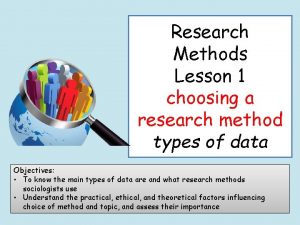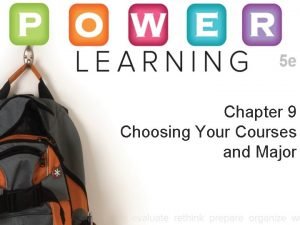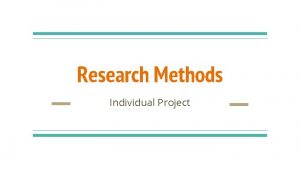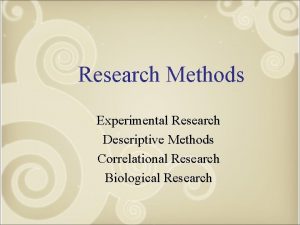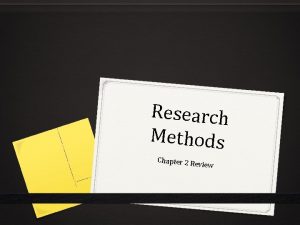CHAPTER 2 Choosing Topics and Methods for Research



















- Slides: 19

CHAPTER 2 Choosing Topics and Methods for Research

Sources of Research Ideas • Your own experience and knowledge. • Brainstorming • Pros? And Cons? • Prior research findings. • Pros and Cons? • Using existing theories. • Pros and Cons?

Reviewing the Literature • Why? – Be informed! • Don’t want to duplicate pre-existing research. • Where the topic currently is. – Help choose and construct a research design. • E. g. , operational definitions of variables.

Types of Literature • Scholarly versus General Sources – Scholarly: For professionals and students. • Written by expects or researchers • Cite references • Little or no general advertising in the source. – General: For general public. • Written by professional writers in well-known sources (e. g. , magazine). • Little referencing of sources • Lots of general advertising (e. g. , cars)

Scholarly Sources • Scholarly Sources are Peer Reviewed! – Other experts or researchers check over the papers of their colleagues before the are published. • Primary Source – Original, firsthand account of an idea or research finding. – E. g. , Journal article of a research report. • Secondary Source – Secondhand information, usually based on the primary source. – E. g. , Text book, newspaper article.

Scholarly Research Reports • Most research reports (primary sources) will contain the following sections: – Abstract – Introduction – Method • Participants • Apparatus and Materials • Procedure – Results – Discussion

Where Do I Find Scholarly Research? • Abstracts – Psychological Abstracts • Older research. Not a lot of fun – tedious, but builds character. • Electronic Databases – Psyc. INFO (web-based) – Psych. LIT (CD-ROM version of Psyc. INFO) – MEDLINE – EBSCOhost

References In Hand, Now What? • Even before you start reading (or have only read the abstracts) – organize them in some fashion (e. g. , methods employed, results found) • Read the “Introduction” sections of each paper noting theories, other references, definitions of variables. • Read the “Discussion” sections of each paper looking for strengths and weaknesses of the methods employed. • Now read the “Method” sections. Which methods do you think are best? Do the different methods explain conflicting results? What needs to be done? Maybe even come up with a hypothesis.

Hypotheses • Good Hypotheses – Make Explicit Predictions – Are Testable and Falsifiable – Provide clear “operational definitions” of variables.

Match Hypothesis to a Research Strategies • Once a hypothesis is in place – which research strategy should you employ? – This will depend on factors like: • The topic and participants you choose • The variables you use • How much control you can have over the situation and variables – There 4 Research Strategies available to you. • • Experimental Quasi-experimental Correlational Descriptive

Experimental Strategy • If you want to draw a cause-effect conclusion then you must run an experimental design or strategy. • Key features include: – Manipulation of a independent variable – Control Condition – Random assignment of participants to groups

Quasi-Experimental • Very similar to experimental except a required element to make a cause-effect conclusion is absent. – e. g. , no random assignment to groups, or no manipulation of the independent variable. • Cannot draw cause-effect conclusions with quasi-experimental designs.

Correlational • Usually participants are measured on two variables and the relationship between the two variables is measured. – Usually no assignment to groups – No manipulation of the independent variable (sometimes called predictor variable). • Hypotheses state a relationship will exist between the variables. • Cannot draw cause-effect conclusions. Can state relationship exists between variables but little more.

Descriptive Strategy • Often used to detail or categorize events. • A hypothesis may be absent. – Descriptive strategies often help to generate hypothesis for correlational, quasiexperimental, or experimental studies. • Cannot draw cause-effect conclusions. Conclusions are descriptive (for lack of a better word) in nature.

Who Will I Study: Participants • Population: entire set of people or animals (the participants) of interest. • Sample: a representative subset of the population that is being studied. – What does representative mean? – How might you go about this? • We’ll have much more to say about this in future chapters.

Materials and Procedures • The materials and procedures you use will depend on a number of factors: – What you want to accomplish? • Cause-and-effect relationship or a relationship? – What materials and procedures been done before and how effective was it. • Do you have access to similar materials? • How expensive is it? • Can I control the variables better?

Applied Vs. Basic Research • Applied Research: – Trying to solve a practical problem. • E. g. , Does a certain nutrient increase immune function? • Basic Research – Tries to answer fundamental or theoretical questions. No focus on practical application. • E. g. , What is the impact of stress on memory?

Laboratory Vs. Field Research • Laboratory Research – A research setting with a high degree of control over: • Who and what is present • How data are collected • What the participants experience • Field Research – Research that occurs in real life situations thus there is less control. • Speculate on the pros and cons of each. – Mundane realism vs. experimental realism.

Generalizability • Will you results stand up if: – You use a different group of participants? – Change the circumstances slightly? – You run the study at a different time (e. g. , winter vs. summer)? • If they do, then your results have “External Validity” or are considered generalizable. • How far should you generalize? – Most psychologists begin with the “continuity assumption” – results are likely to be similar across different individuals, situations, and time periods unless there are substantive reasons to believe otherwise.
 General question in research
General question in research Research methods for business students chapter 5
Research methods for business students chapter 5 Chapter 1 choosing your career
Chapter 1 choosing your career Business ownership
Business ownership A corporation organized to provide a social educational
A corporation organized to provide a social educational Chapter 21 lesson 2 choosing to live alcohol free
Chapter 21 lesson 2 choosing to live alcohol free Chapter 20 tobacco vocabulary practice
Chapter 20 tobacco vocabulary practice Fabrication of wax pattern
Fabrication of wax pattern Operation research
Operation research Research questions for global perspectives
Research questions for global perspectives Technology research topics
Technology research topics Tahapan penelitian dalam psikologi
Tahapan penelitian dalam psikologi Wireless communication research topics
Wireless communication research topics Efl research topics
Efl research topics Action research topics in physics
Action research topics in physics Mobile computing research topics
Mobile computing research topics Data warehouse research topics
Data warehouse research topics Feature of qualitative research
Feature of qualitative research Content analysis research topics
Content analysis research topics Csec pob sba sample
Csec pob sba sample
